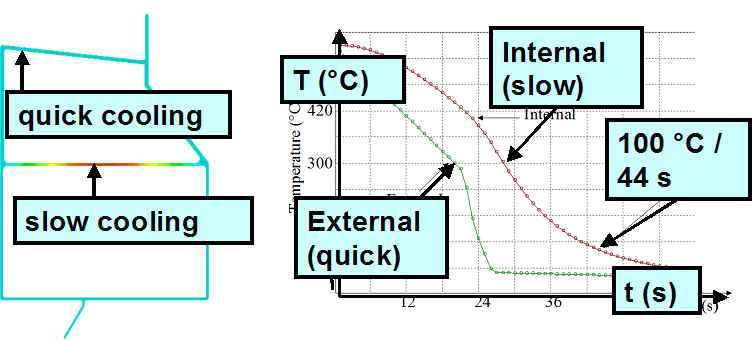Improved cooling
In aluminium extrusion it is important to master the cooling of profiles. Choosing the right set of cooling parameters is a key to ensure profile quality, minimize residual stress and deformation, and improve homogeneity and microstructure. This is why MTD performs virtual cooling trials by transient simulation of profile cooling. The MTD reliable and quick predictive model takes into account data and parameters such as shape, type and number of the different cooling devices, and type of cooling conditions (air, water, spray) in an accurate manner.
In particular, the cooling speed of thick parts and thin parts have to be as homogeneous as possible. Also, for hollow profiles, one has to ensure sufficient cooling speed of the inner parts.

In the case of the profile shown on the figure, the MTD thermal evolution model shows that into the inner part of profile is cooled down to a temperature of 100 degrees Celsius after 44 s of spray cooling. The model was employed to determine the optimal extrusion speed with precision, thus increasing productivity by 30%.
The MTD quick and user friendly Heating and Cooling Optimizer (HCO) is being employed to optimize the cooling of complex shaped profiles. The advantage of HCO is its user friendliness. HCO is well-adapted to production environments and do not require any finite element knowledge (fully automatic and invisible mesh). It includes an input interface with CAD 2D standards.

After 72 s spray cooling, the profile is still warm (over 200 °C) in the red zone, whereas it is already cold at its extremities (blue zones). The graph shows the temperature evolution at given positions.
Optimized cooling thanks numerical simulation is being employed to ensure product quality by adequate control of thermal gradients, and to increase productivity by optimizing the cooling speed.
(Above examples courtesy Alcan Ltd)
Previous topic:Caustic soda
Next topic: Corrector services